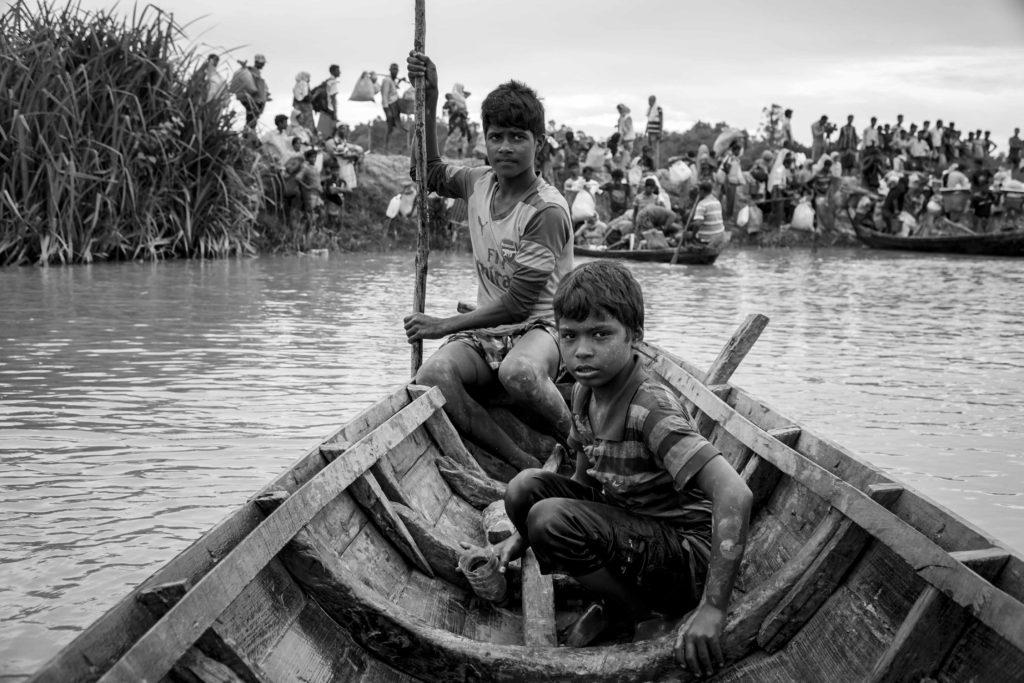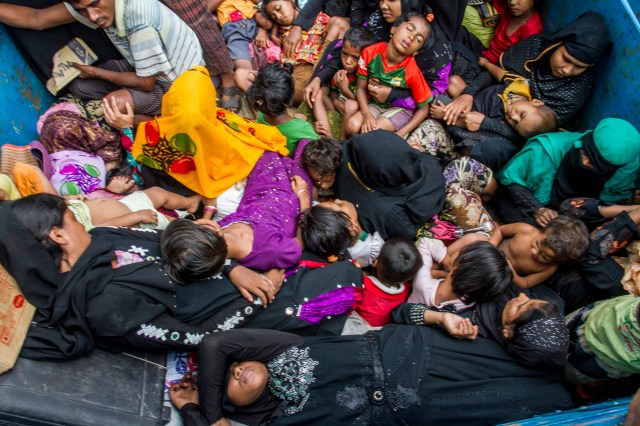Pregnant women and children journeying to Balukhali refugee camp.(Credit Image: © Abdul Ramdzhani Rahman/ZUMA Wire/ZUMAPRESS.com)

Nearly ten years ago, I was sandwiched on a sofa in Colombo between the incoming Iranian ambassador and a tubby, shaven-headed monk in saffron robes and sandals. We were waiting for an audience with Mahinda Rajapaksa (President of Sri Lanka from 2005 to 2015), a jolly rogue who modelled himself on Tony Blair – but with white robes, a crimson scarf, and sandals, as well as jewels on his fingers and toes.
Bored witless with waiting under the sharp gaze of his bodyguards, my eyes focused on some kitschy paintings of medieval Sinhalese warriors on top of elephants. After a week of touring government offices, I knew these were ubiquitous, though I didn’t give the tubby monk further thought.
This was my first brush with something that did not compute with my limited knowledge of Buddhism. As a child in the sixties I had seen shocking footage of Thich Quang Duc (1897-1963) – calmly immolating himself at a Saigon intersection in June 1963, in protest at the corrupt regime of South Vietnam’s president Diem. If there were any violence in Buddhism, it seemed of the self-sacrificial kind. Many of my older ‘hippy’ contemporaries dabbled with Buddhism, without knowing much about its history or its Asian cultural heartlands. The cruelties of the Vietnam War indirectly heightened the international attractions of this ‘religion of peace’.
Buddhism has two major schools of doctrine and practice. The earliest version, known as the Theravadian[1. From the BBC’s guide to religions: “Theravada Buddhism is strongest in Sri Lanka, Cambodia, Thailand, Laos and Burma (Myanmar). It is sometimes called ‘Southern Buddhism’. The name means ‘the doctrine of the elders’ – the elders being the senior Buddhist monks. This school of Buddhism believes that it has remained closest to the original teachings of the Buddha.”], is common to ‘southern’ nations such as Myanmar (formerly Burma), Cambodia, Laos, and Thailand, as well as Sri Lanka as a kind of outlier. The larger reformed school (Mahayana[2. Again from the BBC: “Mahayana Buddhism is not a single group but a collection of Buddhist traditions: Zen Buddhism, Pure Land Buddhism, and Tibetan Buddhism are all forms of Mahayana Buddhism… Mahayana talks a great deal about the bodhisattva (the ‘enlightenment being’) as being the ideal way for a Buddhist to live.”]) is dominant in ‘northern’ China, Tibet, Korea and Japan.
In recent years, three countries in the Theravadian camp have spawned highly militant Buddhist movements: Sri Lanka, which is 70% Buddhist, Myanmar (88%) and Thailand (93%). They feed off each other, with cross-fertilisation between Sri Lankan and Burmese monks who then influence trends in Thailand. Paradoxically, while there is a Malay Muslim insurgent problem in southern Thailand[3. “Spurred by Myanmar radicals, Thai Buddhists push for state religion status” from Reuters, November 2015], there is not in either Myanmar or Sri Lanka. The first two countries illustrate the paradox of a religious majority feeling deeply threatened by minorities, and then practising epic violence against them.
I visited Sri Lanka in the immediate aftermath of Rajapaksa’s final onslaught against the (Hindu) Tamil Tigers – following various failed peace gambits and to end a conflict which had begun in 1983. Some of his generals used their desktop computers to show live-feed battlefield drone footage of the final bloodbath on the Nanthi Kadal lagoon, the culmination of the army’s northern offensive in May 2009 when about five thousand Tigers were slaughtered. I met some of the survivors in army rehabilitation centres for captured child soldiers, most of them boys and girls in their late teens or early twenties, in some cases with shrapnel injuries to their faces and limbs.
The Tamil Tigers were the sharp terrorist end of a much greater perceived threat to the majority Sinhalese from all religious minorities. There may have only been three million Hindu Tamils in Sri Lanka, but there are 60 million more across the sea in Tamil Nadu in southern India.
But even as the war was wound down, Sri Lankan military commanders muttered darkly about ‘jihadists’ (slightly under two million Sri Lankans are Muslims) and there have recently been Buddhist attacks on the even smaller number of Christians (1.2 million, the majority are Roman Catholics). The main instigators are monks from an association called Bodu Bala Sena (Buddhist Power Force) which was founded in 2012. This is also opposed to the ‘blasphemies’ accompanying western liberal modernity epitomised by a ‘Buddha Bar’ in a fancy hotel (Vice report).
Something ominously similar is afoot in Myanmar. As in Sri Lanka, deep history is enlisted to show that everywhere Buddhism is in retreat, from Afghanistan to Turkey via Indonesia. It has been displaced by a triumphal Islam, which since 9/11 has also been widely conflated with violent jihadism.
Although the overwhelming majority of ethnic Burmese are Buddhists, there is a similar sense of threat to that felt by Sinhalese, but from the Muslim Rohingyas in Rakhine state.
As in Sri Lanka, where many Buddhists claim the Tamils were planted on the island as tea workers by the British in the 19th century, many Buddhist Burmese regard the Rohingyas as insidious ‘Bengali squatters’ from Bangladesh, a neighbouring majority Sunni Muslim country with a population of 146 million. In 1982, the military junta stripped the Rohingyas of their Burmese citizenship, which many had held since the British colonial era and which commenced in 1823. Like the Sri Lankan Tamils, the Rohingya were also viewed as beneficiaries of colonialism by oppressed majorities.
To date as a result of ethnic cleansing by the military, over ten thousand Rohingyas have been murdered and a further 680,000 forcibly driven from the country.

Monks are integral to the intolerance, militancy and violence, which in some cases is incited through DVD copies of their sermons. The years straddling Burma’s transition from the military dictatorship established in 1962, to the civilianised rule of Aung San Suu Kyi, saw the rise of successive militant, monk-led Buddhist organisations, as well as Buddhist clergy who opposed military rule.
The first organisation of militant monks was called ‘969’. This is a numerological counterblast to the Muslim ‘786’, signifying ‘Bismillah ar-Rahman ar-Rahim’ or ‘in the name of Allah’, which is printed on stickers to indicate that a restaurant or store sells halal food. The 969 movement conducted an aggressive ‘Buy Buddhist’ campaign, which involved boycotting Muslim-owned businesses. The current vehicle for militant Buddhism is the ‘Organisation for the Protection of Race and Religion’ (or Ma Ba Tha for short). It claims that Muslims are conspiring to take over the country to destroy Buddhism, by stealthy economic colonisation and intermarriage with, or rape of, young Buddhist women. A 2013 sermon by the prominent monk U Wiratha links the two:
“[Muslims] have a lot of money and no one knows where that money mountain is. They use that money to get our young Buddhist women. They show that money to attract our young women…That money will be used to get a Buddhist-Burmese woman, and she will very soon be coerced or even forced to convert to Islam…And the children born of her will become Bengali Muslims and the ultimate danger to our Buddhist nation, as they will eventually destroy our race and our religion. Once they become overly populous, they will overwhelm us and take over our country and make it an evil Islamic nation”.
As in the Christian tradition, horrific violence can be legitimated in what is also a religion of peace, and by highly religious men at that, with a similar resort to sophistic doctrines of defensive or “just” warfare. As in the Old Testament, there are also plenty of warrior kings in Buddhist history (like Dutugamanu who unified Sri Lanka in the 2nd century BC) who can be enlisted to justify the ‘fight back’. This is especially so in societies with deep communal cleavages, and histories to match, where the slightest incident can be fanned into savage violence.
The recent history of religious persecution is not confined to bad things that happen to Christians and Jews, especially in majority Muslim countries, and sometimes it is religious people who are responsible for the persecuting. Including Buddhists.










Join the discussion
Join like minded readers that support our journalism by becoming a paid subscriber
To join the discussion in the comments, become a paid subscriber.
Join like minded readers that support our journalism, read unlimited articles and enjoy other subscriber-only benefits.
Subscribe